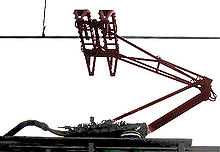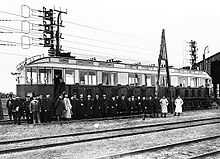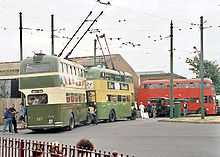Current collector





Electric current collectors are used for trolleybuses, trams, electric locomotives or EMUs to lead electrical power from overhead lines or electrical third rails to the electrical equipment of the vehicles.
Typically, they have one or more spring-loaded arms that permits the working engagement with the rail or overhead wire and a collector or contact shoe in running engagement with the wire or rail. The collector arms pushes the contact shoe against the contact wire or rail. As the vehicle moves, the contact shoe slides along the wire or rail to draw the electricity needed to run the vehicles motor. The current collector arms are electrically conductive but mounted insulated on the vehicles roof, side or base. A samewise insulated cable connects the collector with the switch, transformer or motor. The steel rails of the tracks act as the electrical return.
Electric vehicles that collect their current from overhead line system use different forms of one- or two-arm pantograph collectors, bow collectors or trolley poles. The current collection device presses against the underside of the lowest wire of an overhead line system, which is called a contact wire.
Contact shoe
Electric railways with third rails, or fourth rails, in tunnels carry collector shoes projecting laterally (sideways), or vertically, from their bogies. The contact shoe may slide on top of the third rail (top running), on the bottom (bottom running) or on the side (side running). The side running contact shoe is used on rubber tired metros. A vertical contact shoe is used on ground-level power supply systems, stud contact systems and fourth rail systems. A pair of contact shoes was used on underground current collection systems. The contact shoe on a stud contact system is called a ski collector. The ski collector moves vertically to accommodate slight variations in the height of the studs.
See also
References
| Wikimedia Commons has media related to Current collectors. |
